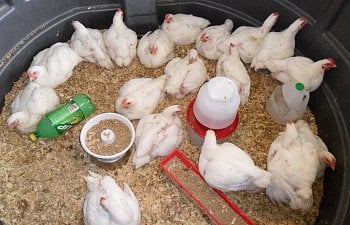How To Raise Chickens for Meat - Tips & Pictures
Raising meat chickens is a very exciting, interesting, and rewarding experience. It is surprisingly easy for all ages and is suitable for someone with limited space. Cornish Rock cross is the most popular breed raised for meat. This breed is a cross between a White Plymouth Rock hen and a Cornish rooster. These broilers are specifically bred to grow very big very quickly. In only 6-8 weeks they go from cute fluffy chicks to large 6 pound chickens ready for processing.
Starting meat chicks is similar to starting egg laying chicks, but there are a few thing you need to know about these little fluff balls.
Before the chicks arrive - Setting up the brooder
- Make sure each chick has a minimum of 1 square foot per chick (more is better).
- The floor of the brooder should be covered with about 4 inches of litter (such as wood shavings).
- For the first week the brooder needs to be 95 degrees in the warmest part (a thermometer is helpful), with some cooler spots where the chicks can hang out. Every week reduce the degrees by five degrees until it reaches 70 degrees.
- For the first few weeks the starter/grower chick feed can be fed.
- A small waterer should be used so that the chicks don't drown.
When the chicks arrive - Getting them settled
- Whether purchased from a hatchery or a feed mill the chicks need to be put in the brooder right away.
- Show the chicks where the water is by gently dipping their beaks in the water one by one as you put them in. They will find the food on their own.
- Watch the chicks for a while. Make sure that they are not too cold or too hot. If they are too cold they will huddle together under the light. If they are too hot they will scatter away from the light. A thermometer is only a guide, the chicks will show you what they need.
- Enjoy their cuteness while it lasts, because it doesn't last long.
Preventing Pasty butt
Pasty butt is common in young broiler chicks purchased from a hatchery. It occurs when poop gets stuck on the downy feathers around the vent. This stops the chick from pooping, resulting in death. A little bit of ACV (Apple Cider Vinegar) added to the chicks' drinking water helps a LOT to prevent this condition. Use a ratio of roughly 3/5 tablespoons of ACV to a gallon water. If pasty butt do occur, do the following:
1. Clean the poop off the vent with warm water and a paper towel.
2. Trim the down around the chick's vent carefully.
3. Put a little bit of olive oil on and around the vent.
4. Check on the chick often and clean when necessary.
(You may need to repeat steps 2 and 3 many times until it goes away)
3 weeks old - Moving them to the grow out coop
At 3 weeks old, the chicks cuteness beings to fade as their yellow downy feathers are replaced by white feathers. At this point some things change.
- The feed should be changed from starter/grower to grower/finisher.
- They need to be moved to a bigger coop
3 week old broilers
My first year raising broilers, they lived in my garage in this coop. They had plenty of ventilation, but it was a headache to clean out the shavings every day. I recommend using a broiler tractor. I used a broiler tractor my second year.
We moved them to a different spot of grass each day. It was much easier and the broilers were healthier and bigger because they got fresh air and bugs. This is also the method commonly used by pasteurized poultry farmers.
*See more options for keeping broilers here: Free range alternatives to broiler pens, tractors, and coops
4-5 weeks old - Getting big
Once the broilers are 4-5 weeks old, the heat bulb can be replaced with a regular bulb (depending on the weather). They have all their feathers by this point and should not need heat. However they still need to have a light on them through the night to encourage eating.
5 week old broiler
Tip -Beating the heat
Most broilers are raised in the spring or summer. But as everyone knows summer can come with some pretty brutal heat. Broilers become over heated much quicker then egg layers because of their extra weight. And it is not unusual to loose countless broilers in the last two weeks because of the heat. One way to solve this problem is by freezing jugs of water and putting them in the coop with the chickens. They will lay next to them and cool themselves off. Also make sure they always have plenty fresh, cool water to drink and adequate shade!
6 weeks old - Ready for processing
Broilers can be processed any where from 6-8 weeks. Usually it depends on their weight at this time. The average weight for a 6 week old broiler is 5-6 pounds. If they are smaller than 5-6 pounds, you can let them grow for another week or two.
6 week old broilers with jugs of frozen water
I hope that this information will help anyone who is thinking of raising broilers and that you enjoy it as much as I do!
Further recommended reading:
- How To Process A Chicken At Home
- Meat Birds ETC (Forum section)
Thanks for reading!
Check out my other articles! -------> Here!

